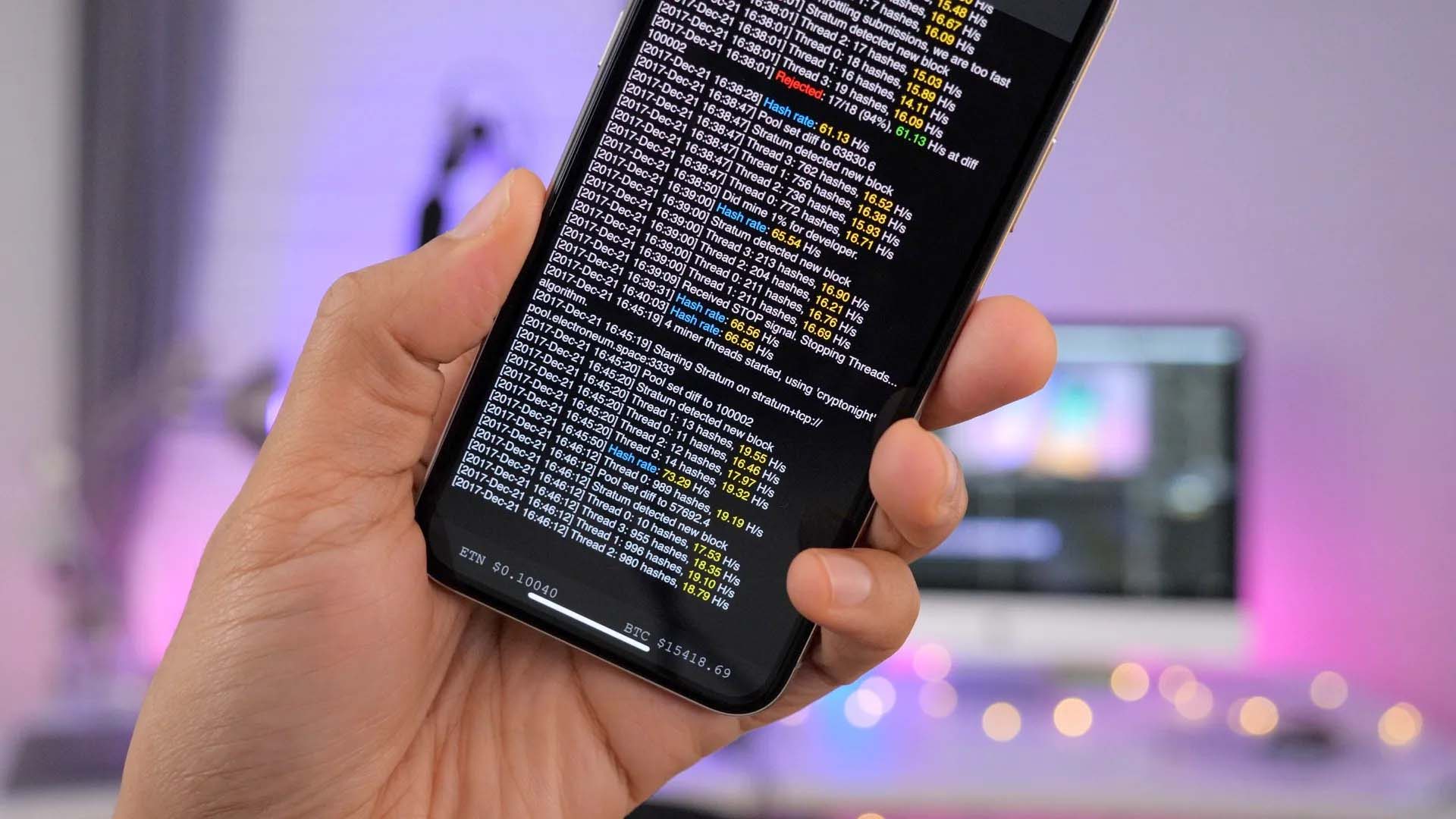

Finance
How To Make A Bot For Trading Cryptocurrency
Published: October 5, 2023
Learn how to create a cryptocurrency trading bot with our step-by-step guide. Gain insights into the finance world and boost your trading strategies.
(Many of the links in this article redirect to a specific reviewed product. Your purchase of these products through affiliate links helps to generate commission for LiveWell, at no extra cost. Learn more)
Table of Contents
- Introduction
- Understanding cryptocurrency trading bots
- Benefits of using a trading bot for cryptocurrency
- Setting up your cryptocurrency trading bot
- Choosing a trading strategy
- Selecting a cryptocurrency exchange
- Setting up an API key for your chosen exchange
- Building the bot framework
- Implementing trading logic
- Testing and optimizing your bot
- Monitoring and adjusting your bot’s performance
- Conclusion
Introduction
Welcome to the exciting world of cryptocurrency trading bots! In recent years, cryptocurrency trading has gained immense popularity, drawing the attention of both seasoned traders and newcomers to the market. As more people explore the potential for wealth creation in the cryptocurrency world, the demand for more efficient and effective trading methods has grown.
Enter the cryptocurrency trading bot – a powerful tool designed to automate trading strategies and execute trades on your behalf. These bots utilize advanced algorithms and artificial intelligence to analyze market trends, indicators, and other relevant data in real-time. By doing so, they can make quicker, more precise trading decisions, allowing you to maximize your profit potential.
The primary purpose of a cryptocurrency trading bot is to eliminate human emotions and biases from trading decisions. Emotions like fear and greed can cloud judgement and lead to poor trading choices. By automating the trading process, bots remove the emotional element entirely, ensuring that trades are executed based on predetermined strategies.
But why should you consider using a trading bot for cryptocurrency? The benefits of using a trading bot are numerous and compelling. Whether you are a seasoned trader looking to streamline your trading process or a beginner exploring the cryptocurrency market, utilizing a bot can greatly enhance your trading experience.
Understanding cryptocurrency trading bots
Cryptocurrency trading bots are computer programs that use algorithms and advanced technology to automate the process of buying and selling cryptocurrencies. These bots are designed to execute trades based on pre-defined rules and strategies, without the need for constant monitoring and manual intervention.
These bots are equipped with various features and capabilities to analyze market data, track price movements, and identify potential trading opportunities. They can monitor multiple exchanges and currency pairs simultaneously, providing traders with a comprehensive view of the market in real-time.
Trading bots can be categorized into two main types: rule-based bots and AI-driven bots. Rule-based bots follow specific pre-programmed rules and strategies. They execute trades based on technical indicators, price trends, and other predetermined criteria. On the other hand, AI-driven bots utilize machine learning algorithms to continuously analyze and adapt to market conditions. These bots can learn from past trades and adjust their strategies accordingly.
Understanding key concepts in cryptocurrency trading is crucial to fully grasp the functionality of trading bots. Some important terms to familiarize yourself with include:
- Exchange: A platform where you can buy and sell cryptocurrencies.
- Currency Pair: The combination of two cryptocurrencies being traded against each other, e.g., Bitcoin/Ethereum (BTC/ETH).
- Market Order: An order to buy or sell a cryptocurrency at the best available price in the market.
- Limit Order: An order to buy or sell a cryptocurrency at a specific price, or better.
- Stop Loss: An order designed to limit potential losses by automatically selling a cryptocurrency if its price reaches a specified level.
Trading bots can be a valuable tool for both beginners and experienced traders. They can help automate repetitive tasks, eliminate emotional biases, and capture potential trading opportunities that might be missed by manual trading. However, it is important to note that cryptocurrency trading bots are not foolproof and should be used with caution. Proper risk management and continuous monitoring are essential to ensure the bot’s effectiveness and to mitigate potential risks.
Benefits of using a trading bot for cryptocurrency
Using a trading bot for cryptocurrency can offer numerous benefits to both beginner and experienced traders. Let’s explore some of the key advantages:
- 24/7 trading: Unlike human traders who need breaks and sleep, trading bots can operate 24 hours a day, 7 days a week. They can monitor the market and execute trades even when you’re away from your computer. This allows you to take advantage of trading opportunities that may arise at any time, including during non-traditional trading hours.
- Emotion-free trading: Emotions such as fear, greed, and FOMO (fear of missing out) can often cloud judgement and lead to poor trading decisions. Trading bots eliminate the emotional element from trading by sticking to pre-programmed rules and strategies. By removing human biases, bots can make objective and rational trading choices based on market conditions and indicators.
- Faster and more efficient execution: Trading bots can analyze market trends, price movements, and indicators in real-time, making lightning-fast trading decisions. They can execute trades at a speed that is simply not achievable for human traders. This can be particularly advantageous in volatile and fast-paced cryptocurrency markets.
- Diversification: Trading bots can handle multiple currency pairs and exchanges simultaneously. This allows you to diversify your trading portfolio and spread the risk across different cryptocurrencies. Bots can monitor and analyze various markets, identifying potential trading opportunities and reducing reliance on a single asset.
- Backtesting and optimization: Many trading bots offer backtesting features, allowing you to test your trading strategies using historical data. This helps you gauge the effectiveness of your strategies and make necessary adjustments before deploying them in live trading. Additionally, you can optimize your bot’s performance by fine-tuning the parameters based on historical data.
- Discipline and consistency: Trading bots strictly adhere to the pre-defined rules and strategies programmed into them. They do not deviate from their strategy due to emotions or external influences. This helps maintain trading discipline and consistency, reducing the likelihood of impulsive decision-making and potential losses.
It’s important to remember that while trading bots offer many benefits, they are not without risks. Cryptocurrency markets can be highly volatile, and bots are only as good as the strategies and parameters set by their users. It’s crucial to have a good understanding of trading concepts and continually monitor and optimize your bot’s performance to ensure its effectiveness.
Setting up your cryptocurrency trading bot
Setting up a cryptocurrency trading bot requires a few essential steps to ensure its proper operation. Let’s go through the process of getting your bot up and running:
- Choose a trading strategy: Before setting up your cryptocurrency trading bot, it’s crucial to determine your trading strategy. Consider factors such as your risk tolerance, investment goals, and preferred trading style. Whether you prefer trend-following strategies, arbitrage, or mean reversion, selecting the right strategy aligns your bot’s actions with your trading objectives.
- Select a cryptocurrency exchange: To start trading cryptocurrencies with a bot, you’ll need to choose a reliable exchange that supports API connectivity. Take into account factors such as exchange reputation, security measures, trading volume, and available trading pairs. Popular exchanges that offer API access include Binance, Coinbase Pro, and Kraken.
- Set up an API key for your chosen exchange: To connect your trading bot to the exchange, you’ll need to generate an API key. The API key allows the bot to access your account and perform trading operations on your behalf. Ensure that you grant the necessary permissions to the API key, granting access to trading functions while keeping withdrawal permissions disabled for security purposes.
- Build the bot framework: Once you have selected an exchange and generated an API key, you need to build the framework for your bot. This typically involves writing code in a programming language such as Python or using existing trading bot frameworks like Zenbot or Gekko. Alternatively, you can opt for user-friendly platforms that offer a visual interface for configuring your trading bot without the need for coding.
- Implement trading logic: In this step, you program your trading bot with the specific trading rules and logic based on your chosen strategy. This may involve setting parameters such as entry and exit points, stop-loss levels, profit targets, and trade sizes. Make sure to test your trading logic thoroughly using historical data and adjust as needed for optimal performance.
- Testing and optimizing your bot: Before deploying your trading bot for live trading, it’s essential to conduct thorough testing. Use simulation modes or paper trading to simulate the bot’s performance in real-market conditions without risking real funds. Monitor the bot’s results, analyze trading outcomes, and fine-tune its parameters to improve performance and minimize potential risks.
- Monitoring and adjusting your bot’s performance: Once your bot is live, it’s crucial to monitor its performance regularly. Keep an eye on its trading activity, assess results, and make necessary adjustments as market conditions change. Stay updated with the latest market trends, news, and indicators to ensure your bot’s strategies stay relevant and adaptable.
Setting up a cryptocurrency trading bot requires careful planning, strategy selection, and continuous monitoring. It’s important to start with small investments and gradually increase your exposure as you gain confidence in your trading bot’s performance. Additionally, staying informed about the fast-paced cryptocurrency market and continuously improving your trading strategies will set you on the path to success.
Choosing a trading strategy
Choosing the right trading strategy is crucial when setting up your cryptocurrency trading bot. The strategy you select will determine the types of trades your bot executes and the overall approach it takes in the market. Here are some key factors to consider when choosing a trading strategy:
- Timeframe: Decide whether you want your bot to focus on short-term or long-term trading. Short-term strategies, such as scalping or day trading, involve making quick trades to take advantage of small price movements. Long-term strategies, on the other hand, focus on capturing larger trends over an extended period. Consider your risk tolerance and the amount of time you can dedicate to monitoring market movements.
- Technical indicators: Technical indicators help to identify potential market trends and price patterns. Common indicators include moving averages, relative strength index (RSI), and Bollinger Bands. Determine which indicators align with your trading goals and incorporate them into your bot’s strategy. Keep in mind that using too many indicators can lead to excessive complexity and may lead to conflicting signals.
- Fundamental analysis: Fundamental analysis involves considering external factors such as news events, regulatory changes, and overall market sentiment. Some traders prefer to base their strategies on fundamental analysis, using market news and data to guide their trading decisions. Integrating fundamental analysis into your bot’s strategy can help identify potential opportunities or avoid risky assets during volatile times.
- Risk management: Implementing proper risk management is vital when selecting a trading strategy. Determine your risk tolerance and set appropriate stop-loss levels to protect your capital. Consider risk-to-reward ratios when placing trades to ensure that potential profits outweigh potential losses. Your bot should have built-in risk management mechanisms to help protect your investment.
- Market conditions: Different trading strategies perform differently under various market conditions. Some strategies may work better during trending markets, while others may be more suitable for ranging or volatile markets. Consider the current market conditions and assess whether your chosen strategy aligns with the market environment.
- Backtesting and optimization: Before deploying your bot, backtest your chosen strategy using historical data. This process allows you to evaluate the performance of the strategy over time and identify potential areas for improvement. Adjust parameters, test different combinations, and optimize your strategy to maximize profitability and minimize risk.
Remember that choosing a trading strategy is a personal decision and depends on your risk appetite, trading goals, and market knowledge. It’s important to have a clear understanding of the strategy you choose and to continuously monitor and evaluate its performance. Be prepared to make adjustments and refinements as market conditions change to ensure your bot remains effective in the dynamic cryptocurrency market.
Selecting a cryptocurrency exchange
When setting up your cryptocurrency trading bot, selecting the right cryptocurrency exchange is crucial. The exchange you choose will directly impact your trading experience, security, and access to various cryptocurrencies. Here are some key factors to consider when selecting a cryptocurrency exchange:
- Reputation and security: One of the most important factors to consider is the reputation and security measures implemented by the exchange. Look for exchanges that have a strong track record of security and have robust measures in place to protect user funds. Research user reviews and check if the exchange has experienced any major security breaches in the past.
- Trading pairs: Consider the range of cryptocurrencies and trading pairs offered by the exchange. If you have specific coins or tokens you want to trade, ensure that the exchange supports them. Additionally, check if the exchange offers fiat-to-cryptocurrency trading pairs if you plan to deposit or withdraw funds in traditional currencies.
- Liquidity: Liquidity refers to the ease of buying or selling a particular cryptocurrency on an exchange. Higher liquidity ensures that you can execute trades quickly and at desired prices. Look for exchanges with high trading volumes to avoid potential issues with executing trades or slippage.
- Trading fees: Exchanges typically charge fees for executing trades on their platforms. Compare the fee structures of different exchanges to ensure they align with your trading strategy and volume. Some exchanges offer discounted fees for high-volume traders or loyalty programs that can help reduce trading costs.
- User experience: Consider the user interface and overall experience offered by the exchange. A well-designed and user-friendly interface can make trading more convenient and efficient. Look for features such as live charts, order books, and easy navigation to enhance your trading experience.
- API access: To connect your trading bot to the exchange, you will need to ensure that the exchange provides API access. Check if the exchange offers a reliable and well-documented API that supports the functionality you require for your trading bot.
- Regulatory compliance: Depending on your location and preference, you may want to choose an exchange that complies with relevant regulatory requirements. Some exchanges are more compliant and transparent than others, which can provide a higher level of trust and credibility.
- Customer support: Consider the level of customer support provided by the exchange. Look for exchanges that offer responsive and helpful customer support to assist you in case of any issues or inquiries.
Take time to research and compare different exchanges based on these factors before making your final decision. It’s important to choose a reputable exchange that aligns with your specific trading needs and provides a secure and user-friendly trading environment. Remember that your choice of exchange can significantly impact your overall trading experience and success when using a cryptocurrency trading bot.
Setting up an API key for your chosen exchange
Setting up an API key is a crucial step in connecting your cryptocurrency trading bot to your chosen exchange. The API key allows your bot to access and interact with your exchange account, enabling it to execute trades on your behalf. Here’s a step-by-step guide on how to set up an API key for your chosen exchange:
- Sign in to your exchange account: Log in to your account on the cryptocurrency exchange you have selected.
- Navigate to the API settings: Once you are logged in, locate the API settings or API management section within the exchange’s user interface. This is typically found in the account settings or profile menu.
- Create a new API key: Click on the option to create a new API key. You may be required to provide additional security measures, such as two-factor authentication, to proceed with the API key creation process.
- Configure API key permissions: When creating the API key, you will have the option to configure the permissions associated with it. It is essential to grant the necessary permissions for your trading bot to function correctly. Typically, these permissions include the ability to execute trades, access account balance information, and view transaction history. It is advisable to disable the withdrawal permission for added security.
- Generate and secure the API key: After configuring the permissions, generate the API key. The exchange will typically provide you with an API key and a corresponding secret key. It’s crucial to store these keys securely, as they grant access to your exchange account. Treat them as sensitive information and do not share them with anyone.
- Test the API key: Some exchanges allow you to test the API key by making a simple API request to ensure that it is functioning correctly. Take advantage of this feature to verify that your API key is working as expected before connecting it to your trading bot.
- Integrate the API key into your trading bot: Once you have generated the API key, you can integrate it into your trading bot’s code or interface. Follow the documentation or guidelines provided by your trading bot platform or framework to establish the connection between your bot and the exchange using the API key.
- Monitor and manage your API key: Regularly monitor the activity of your API key and review the permissions associated with it. If you no longer use a specific trading bot or suspect any unauthorized access, consider deactivating or regenerating the API key as a security measure.
Setting up an API key for your chosen exchange is a crucial step in establishing the connection between your trading bot and the exchange. By following the exchange’s API key creation process and securing the key, you can enable your bot to execute trades on your behalf and access relevant account information to enhance your trading experience.
Building the bot framework
Building the bot framework is a critical step in setting up your cryptocurrency trading bot. This step involves creating the foundation and structure for your bot’s functionality. Here are some key considerations when building the bot framework:
- Select a programming language: Choose a programming language that is suitable for your bot’s development. Popular programming languages for building cryptocurrency trading bots include Python, JavaScript, and Java. Consider factors such as your familiarity with the language, available libraries and frameworks, and the community support for that language.
- Choose a trading bot framework: If you prefer a more streamlined development process, you can opt for existing trading bot frameworks. These frameworks provide pre-built functionalities and trading strategies that you can customize to suit your needs. Examples of popular trading bot frameworks include Zenbot, Gekko, and Catalyst.
- Set up a development environment: Prepare your development environment with the necessary tools and software. Install the required programming language, libraries, and integrated development environment (IDE) to facilitate the development process. Setting up a version control system such as Git can also help with code management and collaboration.
- Design the bot architecture: Plan and design the architecture of your bot. Define the different components and modules that will make up your bot, such as data gathering, trading strategy, risk management, and interface to interact with the exchange. Break down your bot’s functionality into smaller, modular components to make it more maintainable and scalable.
- Implement connectivity with the exchange: Integrate your bot with the chosen exchange’s API. Use the API key generated from the exchange to establish the connection between your bot and the exchange. Implement the necessary functions to retrieve market data, execute trades, and manage your account.
- Data gathering and analysis: Develop the functionality to gather and process relevant market data for your trading strategies. Retrieve real-time or historical data such as price feeds, volume, and technical indicators. Implement data analysis and manipulation techniques to identify potential trading opportunities.
- Trading strategy implementation: Program your bot with the specific trading strategy you have chosen. Implement the logic and rules for entering and exiting trades, risk management parameters, and position sizing. Consider factors such as technical indicators, price patterns, and market conditions to guide your trading decisions.
- Error handling and logging: Incorporate error handling mechanisms and proper logging to ensure the stability and reliability of your bot. Implement error checks to handle potential issues, such as connectivity problems, erroneous data, or order execution failures. Logging functionality helps track and analyze the bot’s actions and can be useful for debugging and performance optimization.
- Backtesting and simulation: Create the capability to backtest and simulate your bot’s performance using historical data. This allows you to evaluate the effectiveness of your trading strategy and make necessary adjustments. Develop a testing framework that enables you to compare the bot’s performance under different market conditions and parameter settings.
- Continuous integration and deployment: Implement automated processes for continuous integration and deployment of your bot’s code. Automate the build, testing, and deployment processes to ensure efficient and consistent updates. This facilitates easy deployment of updates, bug fixes, and enhancements to your live trading bot.
Building the bot framework requires careful planning, consideration of various factors, and an understanding of the complexities involved in developing a trading bot. Whether you choose to build your bot from scratch or use existing frameworks, focusing on modular design, data analysis, and error handling will contribute to the robustness and effectiveness of your cryptocurrency trading bot.
Implementing trading logic
Implementing trading logic is a crucial step in developing your cryptocurrency trading bot. This step involves translating your trading strategy into code and programming the logic that will guide your bot’s trading decisions. Here are some key considerations when implementing trading logic:
- Translate your trading strategy: Take the trading strategy you have chosen and translate it into clear and precise rules that can be programmed. Define the conditions that signal potential entry points, exit points, stop-loss levels, and profit targets. Consider using technical indicators, price patterns, and market trends as criteria for your trading decisions.
- Break down into manageable code sections: Divide your trading logic into manageable sections or functions to enhance code organization and readability. For example, you can have separate code blocks for trade entry, trade exit, and risk management. This modular approach makes your code easier to maintain and allows you to update specific sections without affecting the entire trading logic.
- Implement risk management: Incorporate risk management measures into your trading logic to protect your capital and manage potential losses. Set stop-loss levels or trailing stops to automatically exit trades if the price moves against you. Consider position sizing techniques to determine the appropriate trade size based on your risk tolerance and account balance.
- Utilize technical indicators: If your trading strategy involves technical analysis, use technical indicators to enhance decision-making. Implement the necessary functions to calculate and interpret indicators such as moving averages, relative strength index (RSI), or Bollinger Bands. Consider how these indicators will guide your bot’s trading decisions based on the defined strategy.
- Account for risk-reward ratio: Take into account the risk-reward ratio when opening trades. Set realistic profit targets based on the potential profit relative to the potential loss. Ensure that your trading logic aligns with your desired risk-reward ratio and consider trailing stops or partial profit-taking as the trade progresses in your favor.
- Plan for different market conditions: Consider implementing logic that adapts to different market conditions. Your bot should have the flexibility to adjust its trading strategy based on market volatility, trends, or specific events. Implement decision-making mechanisms that assess the current market conditions and adjust the trading logic accordingly.
- Consider transaction costs: Take into account the trading fees and other transaction costs associated with executing trades. Incorporate these costs into your trading logic to ensure that your strategy remains profitable after accounting for the fees.
- Backtest and fine-tune: After implementing the trading logic, conduct thorough backtesting using historical data to evaluate its performance. Analyze the results and make necessary adjustments to optimize the strategy. Look for potential weaknesses or areas of improvement and iterate on your trading logic to enhance its effectiveness.
Implementing trading logic requires a deep understanding of your trading strategy and the ability to translate it into code. Pay attention to risk management, technical indicators, market conditions, and transaction costs as you develop the logic. Regularly backtest and fine-tune your trading logic to ensure that it aligns with your goals and adapts to changing market dynamics.
Testing and optimizing your bot
Testing and optimizing your cryptocurrency trading bot is a crucial step to ensure its effectiveness and profitability. Thorough testing allows you to evaluate its performance, identify potential issues or weaknesses, and make necessary adjustments. Here are key considerations when testing and optimizing your bot:
- Simulation mode: Most trading bot frameworks offer a simulation or paper trading mode. Utilize this mode to test your bot’s performance in a simulated trading environment using historical market data. This allows you to evaluate how your bot would have performed in real-market conditions without risking real funds. Analyze the results and compare them to your expectations and desired outcomes.
- Historical data testing: Backtest your bot using historical data to assess its performance across a range of market conditions. Use different time periods, volatile and stable market phases, and various cryptocurrencies to validate the bot’s profitability and performance consistency. Analyze the backtest results to identify potential strengths and weaknesses in your bot’s strategy.
- Parameter optimization: Fine-tune your trading bot’s parameters to optimize its performance. Adjusting parameters such as stop-loss levels, take-profit targets, and risk management settings can significantly impact your bot’s profitability. Utilize optimization techniques like grid search or genetic algorithms to systematically test different parameter combinations and identify the optimal settings for your bot.
- Forward testing: After validating your bot’s performance with historical data, conduct forward testing using real-time or delayed data. Forward testing helps confirm that your bot is making accurate and timely trading decisions in the current market environment. Monitor the bot’s performance carefully, compare it with the expected results, and make necessary adjustments if deviations occur.
- Real-time monitoring: Continuously monitor your bot’s activities and performance when it’s live. Use real-time data to assess how your bot is executing trades, managing risks, and adapting to market conditions. Keep track of its win/loss ratio, profit/loss ratio, and overall portfolio performance. Real-time monitoring helps identify any issues or unexpected behavior and allows you to take corrective actions promptly.
- Risk management review: Regularly review and update your bot’s risk management parameters. Assess the effectiveness of your stop-loss levels, position sizing, and other risk controls. Analyze trade patterns and performance metrics to ensure that your bot is maintaining a healthy risk profile. Adjust risk management settings as necessary to align with your risk tolerance and trading objectives.
- Continuous optimization: The cryptocurrency market is dynamic and evolving. Regularly update and optimize your bot’s trading strategies to adapt to changing market conditions. Stay informed about market trends, news, and economic indicators to incorporate relevant information into your trading logic. Continuously test, analyze, and refine your bot’s performance to ensure its long-term viability.
Testing and optimizing your bot is an ongoing process. It requires diligence, patience, and an iterative approach to achieve consistent profitability. Regularly review and improve your bot’s performance, keeping in mind the dynamic nature of the cryptocurrency market, and make adjustments to maintain its relevance and effectiveness.
Monitoring and adjusting your bot’s performance
Continuously monitoring and adjusting your cryptocurrency trading bot’s performance is vital to ensure its effectiveness and adaptability to changing market conditions. Here are key considerations when monitoring and adjusting your bot:
- Real-time performance tracking: Monitor your bot’s performance in real-time, tracking important metrics such as profit and loss, win/loss ratio, and overall portfolio performance. Use trading platforms, API logs, or bot-specific dashboards to keep an eye on your bot’s activities and assess its profitability.
- Performance benchmarking: Establish benchmarks or performance goals to assess your bot’s success. Compare its performance against industry standards, market benchmarks, or other metrics to evaluate its efficiency. Regularly review and analyze the bot’s performance to determine if it meets your expectations and if any adjustments are necessary.
- Identify strengths and weaknesses: Analyze the bot’s trading patterns and results to identify its strengths and weaknesses. Assess which market conditions it performs well under and which situations may cause suboptimal outcomes. Understanding its strengths and limitations allows you to make informed adjustments to improve its overall performance.
- Evaluate risk parameters: Continuously review and evaluate your bot’s risk management parameters. Assess if the stop-loss levels, position sizing, and risk controls are appropriate for the current market conditions and your risk tolerance. Make adjustments as necessary to ensure that your bot is managing risk effectively and protecting your capital.
- Adapt to changing market conditions: The cryptocurrency market is dynamic and can experience rapid changes. Stay informed about market trends, news, and events that could impact your bot’s performance. Continuously analyze and adjust your bot’s trading strategy to adapt to new market conditions and take advantage of emerging opportunities.
- Regular backtesting and optimization: Perform periodic backtesting and optimization to test your bot’s performance using historical data. Evaluate how changes in the market and adjustments to your trading strategy impact its results. Fine-tune parameters, optimize algorithms, and test different scenarios to improve your bot’s performance and profitability.
- Keep abreast of platform updates: If you are using a third-party platform or framework for your trading bot, stay updated with any platform updates, bug fixes, or new features. Pay attention to release notes or changelogs to determine if there are any changes that could impact your bot’s functionality or performance. Upgrade your bot’s framework or code as needed to ensure optimal performance.
- Continuous learning and research: Stay engaged with the cryptocurrency market and continue learning about trading strategies, indicators, and new technologies. Engage in research, read relevant news, and participate in trading communities to gain insights and stay ahead of the curve. Apply new knowledge and findings to enhance your bot’s performance over time.
Monitoring and adjusting your bot’s performance requires active involvement and proactive decision-making. Continuously evaluating its strengths and weaknesses, adapting to market conditions, and incorporating new insights will help improve its profitability and overall performance. Regularly assess its performance, make necessary adjustments, and stay informed to ensure that your bot remains effective in the ever-changing cryptocurrency market.
Conclusion
Utilizing a cryptocurrency trading bot can be a powerful tool to automate your trading strategies and maximize your profit potential in the dynamic world of cryptocurrencies. By removing human emotions, enabling 24/7 trading, and offering faster execution, trading bots offer a range of benefits to both beginner and experienced traders.
When setting up your cryptocurrency trading bot, it’s essential to carefully consider and implement various components. This includes selecting a suitable trading strategy, choosing a reputable cryptocurrency exchange with API access, and building a robust bot framework. Implementing trading logic based on your chosen strategy, rigorous testing, and continuous optimization are crucial for ensuring the bot’s effectiveness and adaptability.
Monitoring and adjusting your bot’s performance is an ongoing process. Keeping track of real-time performance metrics, evaluating risk management parameters, and adapting to changing market conditions are essential for maintaining long-term profitability. Regular backtesting, fine-tuning of parameters, and staying informed about industry trends and developments will help you stay ahead and optimize your bot’s performance.
It’s important to approach cryptocurrency trading bot usage with caution and maintain realistic expectations. While bots can significantly streamline the trading process and enhance profitability, they are not foolproof and cannot guarantee guaranteed returns. Successful trading still requires discipline, proper risk management, and continuous learning.
In conclusion, investing time and effort into setting up and optimizing your cryptocurrency trading bot can be a rewarding endeavor. With the right strategy, proper risk management, continuous monitoring, and periodic optimization, your bot can become a powerful tool in your cryptocurrency trading journey.














